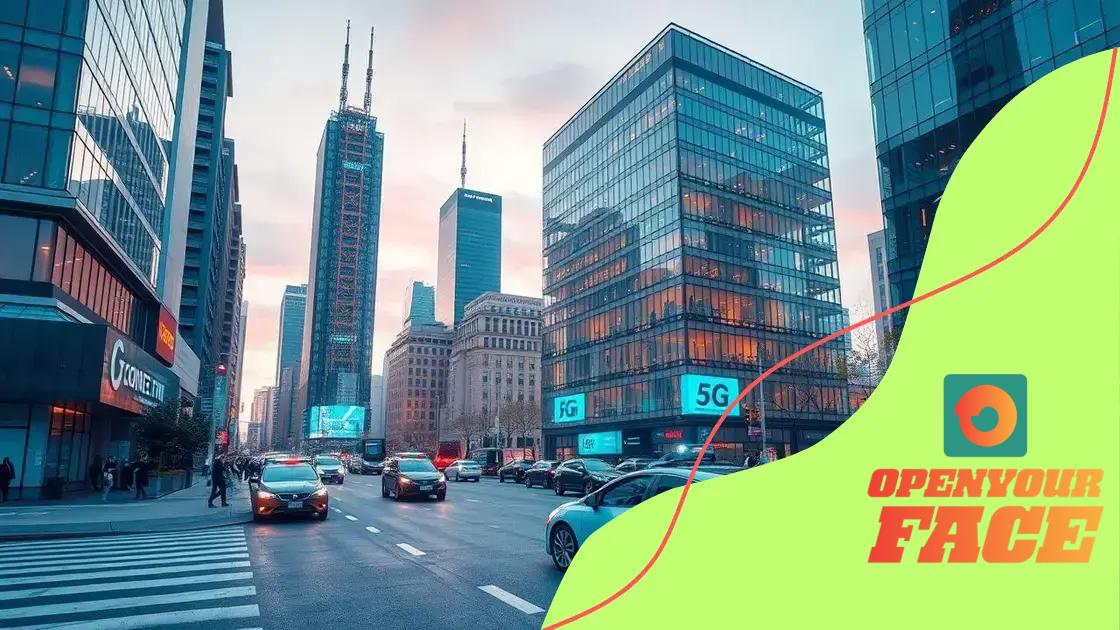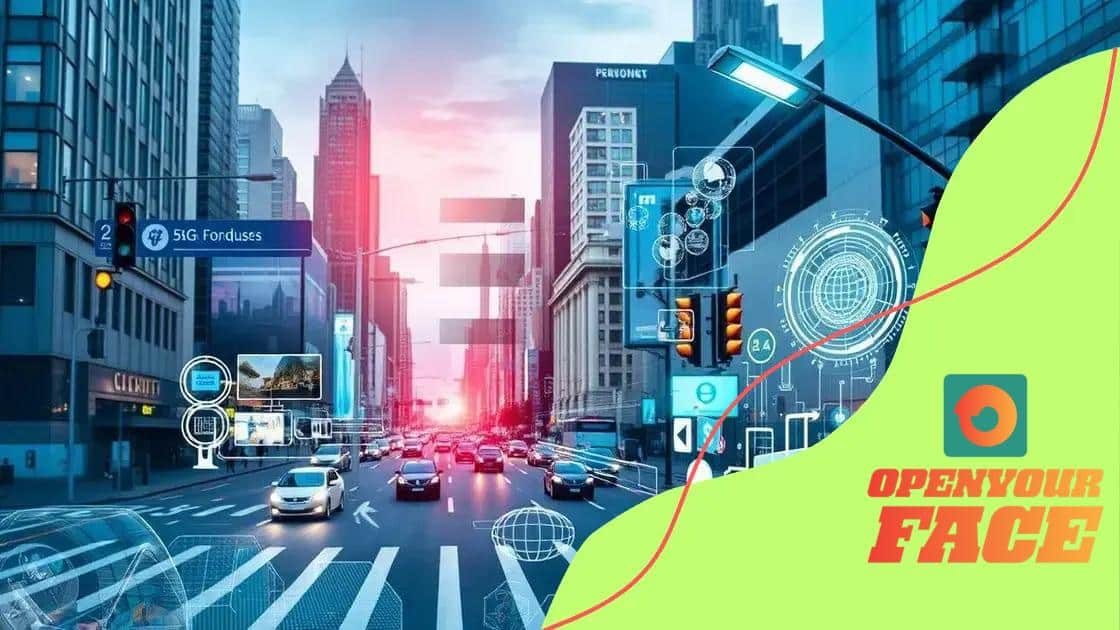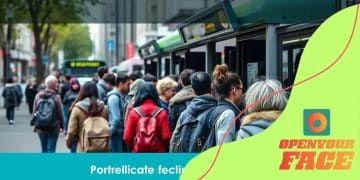How 5G networks are enabling smart city development

5G networks are enabling smart city development by providing faster connectivity, enhancing public safety, optimizing transportation, and supporting sustainable urban management through innovative technologies and real-time data analysis.
How 5G networks are enabling smart city development is at the forefront of urban transformation. Have you ever wondered how technology shapes the cities we live in? Let’s explore this fascinating intersection.
Understanding 5G technology and its benefits
Understanding 5G technology is essential for anyone who wants to grasp the future of connectivity. This new generation of wireless technology brings numerous benefits that can enhance our daily lives, especially in urban environments.
5G stands for the fifth generation of mobile network technology. It promises to deliver incredibly fast data speeds, lower latency, and the ability to connect many devices at once. But what does this mean for smart cities?
Key Features of 5G
5G technology delivers transformative capabilities:
- High speed: 5G can be up to 100 times faster than 4G.
- Low latency: The response time can be as low as 1 millisecond, which is vital for real-time applications.
- Massive IoT connectivity: It can support up to a million devices per square kilometer.
These features create opportunities for innovation in transportation, healthcare, and public safety. For example, imagine cars that communicate with traffic signals or emergency services that receive real-time data during crises. This is the potential impact of 5G on smart city development.
Moreover, the ability to connect **numerous devices** simultaneously will lead to a surge in the Internet of Things (IoT). This means everyday objects can become “smart,” working together for greater efficiency. For instance, smart lighting systems can adjust based on traffic patterns, reducing energy consumption.
As cities grow, so does the need for advanced infrastructure. 5G networks are designed to meet these demands, enabling seamless communication across various tech platforms. This integration enhances services like public transport, reducing wait times and improving reliability for commuters.
In summary, understanding 5G technology is crucial for realizing its **benefits**. The speed, connectivity, and efficiency provided by 5G will be foundational for building smarter, more responsive urban environments. Embracing this technology can transform how cities function and improve the quality of life for their residents.
Key components of smart cities empowered by 5G
The key components of smart cities empowered by 5G technology focus on enhancing urban life through innovation and connectivity. Cities worldwide are utilizing this advanced network to create a seamless living environment for their residents.
Smart cities leverage various technologies, including sensors, IoT devices, and data analytics. These technologies enable better communication between city services and residents. For instance, sensors can detect traffic patterns and adjust traffic lights accordingly to reduce congestion.
Core Technologies in Smart Cities
Several core technologies work together in a smart city:
- IoT devices: These include devices like smart meters and environmental sensors that collect data.
- Data analytics: Analyzing the collected data can lead to better city planning and improved services.
- Connected transportation: This ensures that public transport is efficient and responsive to real-time conditions.
The integration of 5G supports these technologies, providing the high-speed internet necessary for continuous real-time data transmission. With increased bandwidth, multiple devices can communicate simultaneously, fostering a more interactive urban infrastructure. For example, smart traffic lights can optimize their timing based on real-time traffic flow, improving commute times.
Moreover, 5G facilitates advancements in public safety. High-quality video surveillance can enhance security in public areas, while emergency response systems can function at peak efficiency due to reliable communications. A connected city thrives on fast and efficient data sharing, making it easier to manage resources and services.
Developing smart cities means embracing sustainability as well. Renewable energy sources can be better managed with smart grids, reducing overall energy consumption and carbon footprints. The result is not only a more efficient urban environment but also a healthier planet.
Real-world examples of smart cities using 5G

Real-world examples of smart cities using 5G provide insight into how this technology is transforming urban environments. Various cities across the globe are implementing 5G to enhance services, improve efficiency, and create a better living experience for their residents.
One notable example is Barcelona. This city has integrated 5G to support a range of smart applications, from smart traffic management to public safety initiatives. With the deployment of 5G, traffic signals are optimized in real time, reducing congestion and improving travel times.
Smart City Initiatives
Many cities are adopting innovative strategies with 5G:
- Seoul: This city is utilizing 5G to enhance public safety through surveillance cameras that can analyze live feeds and detect unusual activity.
- San Francisco: The city is exploring 5G for smart street lighting, which adjusts brightness based on pedestrian movement, saving energy.
- Dubai: Here, 5G supports a range of IoT devices that collect data on public transportation, making it more efficient and responsive.
These examples illustrate how smart cities leverage 5G technology for various applications. In Singapore, the city-state employs 5G to enable smart sensors throughout the urban landscape. These sensors monitor air quality, traffic flow, and energy usage, helping city planners make informed decisions.
Furthermore, in China, cities like Shenzhen are advancing their public transport systems using 5G connectivity. Real-time updates keep commuters informed about bus arrivals and traffic conditions, leading to a smoother travel experience. Similarly, cities are utilizing 5G to deploy smart waste management systems, which optimize collection routes based on real-time data.
As these real-world examples show, the integration of 5G into urban planning is paving the way for smarter, more efficient cities. The advancements made by cities utilizing 5G technology highlight its importance for the future of urban living.
Challenges and solutions in implementing 5G
The challenges and solutions in implementing 5G technology are significant as cities aim to modernize their infrastructure. While the advantages of 5G are clear, several obstacles can hinder its deployment.
One major challenge is the need for extensive infrastructure upgrades. Many cities must install new base stations and enhance existing ones to handle the increased capacity and speed of 5G. This can be costly and time-consuming, requiring a well-thought-out plan and investment.
Key Challenges of 5G Implementation
- High Costs: Upgrading infrastructure may require significant funding, which can strain budgets.
- Regulatory Hurdles: Cities must navigate various regulations and secure permits to install new equipment.
- Technology Compatibility: Integrating 5G with existing systems can prove complex and may require additional resources.
Despite these challenges, cities are finding innovative solutions to facilitate the rollout of 5G. One approach is to establish partnerships with private companies. These collaborations can ease the financial burden and share resources for infrastructure development. By working together, cities and telecom providers can create a network that is efficient and far-reaching.
Another solution involves leveraging existing technologies. For example, cities can upgrade current towers or utilize small cell technology to enhance coverage without massive investments. This method helps to ensure that urban areas have access to high-speed connectivity without needing to build new structures.
Additionally, public awareness and community involvement play crucial roles in overcoming resistance to 5G deployment. By educating residents about the benefits of 5G technology, cities can foster support for infrastructure projects. Open dialogues can address health concerns and misinformation, making it easier to implement necessary upgrades.
In summary, while the challenges of implementing 5G are significant, innovative solutions are at hand. Cities that invest in collaboration, technology upgrades, and community engagement are more likely to succeed in creating smart, connected environments.
Future trends in smart city development with 5G
The future trends in smart city development with 5G show a promising vision for urban living. As cities around the world embrace 5G technology, we can expect various advancements that will enhance the efficiency and livability of urban areas.
One key trend is the integration of artificial intelligence and machine learning into city services. With the fast data speeds of 5G, cities will be able to analyze vast amounts of data in real-time, leading to smarter decision-making. For instance, traffic management systems will be able to adjust signals based on current conditions, significantly reducing congestion.
Emerging Innovations
Several innovations are expected to emerge from the combination of 5G and smart city initiatives:
- Autonomous vehicles: These vehicles will rely on 5G for quick data transmission, allowing them to react promptly to their environments.
- Smart utilities: 5G will enable more efficient energy and water management through smart meters that provide real-time usage data.
- Telemedicine services: Health services can be optimized with 5G, allowing remote consultations and quick access to medical resources.
As cities become more connected, public safety will also improve. 5G-enabled surveillance systems will provide law enforcement with real-time data, assisting in crime prevention and response. Emergency services will be better equipped to manage crises with the quick exchange of information and real-time analytics.
Furthermore, sustainability is a major focus for future trends. Smart cities will leverage 5G to monitor environmental conditions, optimize resource allocation, and promote green technologies. For example, smart waste management systems can analyze waste levels and schedule pickups only when needed, reducing operational costs and environmental impact.
Interactive public spaces will also become more prevalent as cities implement augmented reality (AR) features. Citizens will use AR applications to navigate their environments and access city services, creating a more engaging urban experience. Overall, the fusion of 5G with smart city initiatives is set to create more connected, efficient, and sustainable urban spaces.
5G technology is transforming smart city development by enabling innovative solutions and improving urban life. With faster connectivity and real-time data analysis, cities can enhance transportation, public safety, and sustainability. The future looks bright as more cities embrace 5G to create smarter environments, making our cities more efficient and livable.
FAQ – Frequently Asked Questions about 5G and Smart Cities
What are the main benefits of 5G technology for smart cities?
5G technology provides faster data speeds, lower latency, and improved connectivity, enabling smarter transportation and more efficient public services.
How does 5G enhance public safety in urban areas?
5G supports real-time surveillance systems and emergency response services, allowing for quicker reaction times and better communication during crises.
What role does AI play in smart city development with 5G?
AI enhances data analysis and decision-making, allowing cities to optimize traffic management, resource allocation, and other urban services.
Are there any challenges in implementing 5G for smart cities?
Yes, challenges include high infrastructure costs, regulatory hurdles, and the need for technology compatibility, but solutions like partnerships and using existing infrastructure can help.






